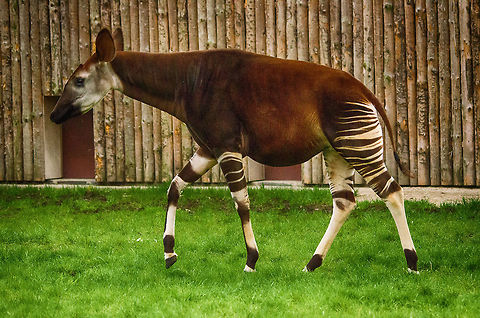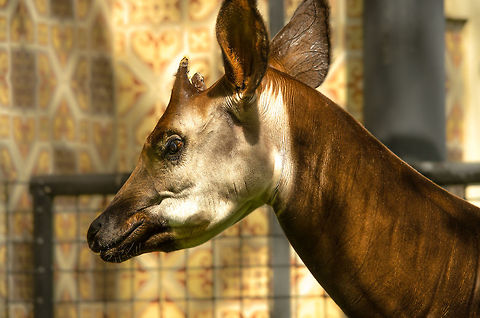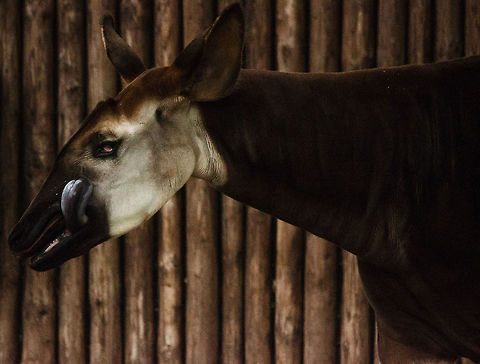
Appearance
Okapis have reddish dark backs, with striking horizontal white stripes on the front and back legs, making them resemble zebras from a distance. These markings possibly help young follow their mothers through the dense rain forest and may also serve as camouflage.The body shape is similar to that of the giraffe, except okapis have much shorter necks. Like the giraffe, the okapi has long legs and a robust body. Both species have very long , flexible tongues used to strip leaves and buds from trees.
The okapi's tongue is also long enough for the animal to wash its eyelids and clean its ears . This sticky tongue is pointed and bluish-grey in colour like that of the giraffe. Male okapis have short, skin-covered horns called ossicones. Their large ears help them detect their predator, the leopard.
Okapis are 1.9 to 2.5 m long and stand 1.5 to 2.0 m high at the shoulder. They have 30- to 42-cm-long tails. Their weight ranges from 200 to 350 kg .
Okapis are primarily diurnal, although recent photo captures have challenged this long-held assumption. One photograph of an okapi feeding in the Watalinga Forest of Virunga National Park, was taken at half-past two in the early morning, thus demonstrating that they also feed at night. Okapis are essentially solitary, coming together only to breed, with the exception of mothers and offspring. Breeding behaviours include sniffing, circling, and licking each other.
Okapis forage along fixed, well-trodden paths through the forest. They have overlapping home ranges of several square kilometers and typically occur at densities of about 0.6 animals per km2 . They are not social animals, and prefer to live in large, secluded areas. This has led to problems with the okapi population due to the shrinking size of their habitats. This lack of territory is caused by human land development and other limiting social factors.
Okapis have several methods of communicating their territory, including scent glands on each foot that produce a tar-like substance, as well as urine marking. The male is protective of his territory, but allows females to pass through the domain to forage.

Naming
The generic name ''Okapia'' derives from the Lese Karo name ''o'api'', while the specific name is in recognition of the explorer Harry Johnston, who organized the expedition that first acquired an okapi specimen for science from the Ituri Forest in the Democratic Republic of the Congo.
Status
Okapis are classified as endangered since 2013; they are endangered by habitat destruction and poaching. The world population is estimated at 10,000–35,000. Conservation work in the Democratic Republic of the Congo by the Okapi Conservation Project includes the continuing study of okapi behaviour and lifestyle, which led to the creation in 1992 of the Okapi Wildlife Reserve. The Congo Civil War threatened both the wildlife and the conservation workers in the reserve.An important captive-breeding centre at Epulu, at the heart of the reserve, is managed jointly by the Congolese Institute for Nature Conservation and Gilman International Conservation, which in turn receives support from other organisations including UNESCO, the Frankfurt Zoological Society and WildlifeDirect as well as from zoos around the world. The Wildlife Conservation Society is also active in the Okapi Wildlife Reserve.
On 8 June 2006, scientists reported evidence of surviving okapis in Congo's Virunga National Park. This had been the first official okapi sighting in that park since 1959, after nearly half a century. In September 2008, the Wildlife Conservation Society reported one of their camera traps in Virunga National Park had snapped the first photo ever taken of an okapi in the wild.
Behavior
Okapis have reddish dark backs, with striking horizontal white stripes on the front and back legs, making them resemble zebras from a distance. These markings possibly help young follow their mothers through the dense rain forest and may also serve as camouflage.The body shape is similar to that of the giraffe, except okapis have much shorter necks. Like the giraffe, the okapi has long legs and a robust body. Both species have very long , flexible tongues used to strip leaves and buds from trees.
The okapi's tongue is also long enough for the animal to wash its eyelids and clean its ears . This sticky tongue is pointed and bluish-grey in colour like that of the giraffe. Male okapis have short, skin-covered horns called ossicones. Their large ears help them detect their predator, the leopard.
Okapis are 1.9 to 2.5 m long and stand 1.5 to 2.0 m high at the shoulder. They have 30- to 42-cm-long tails. Their weight ranges from 200 to 350 kg .
Okapis are primarily diurnal, although recent photo captures have challenged this long-held assumption. One photograph of an okapi feeding in the Watalinga Forest of Virunga National Park, was taken at half-past two in the early morning, thus demonstrating that they also feed at night. Okapis are essentially solitary, coming together only to breed, with the exception of mothers and offspring. Breeding behaviours include sniffing, circling, and licking each other.
Okapis forage along fixed, well-trodden paths through the forest. They have overlapping home ranges of several square kilometers and typically occur at densities of about 0.6 animals per km2 . They are not social animals, and prefer to live in large, secluded areas. This has led to problems with the okapi population due to the shrinking size of their habitats. This lack of territory is caused by human land development and other limiting social factors.
Okapis have several methods of communicating their territory, including scent glands on each foot that produce a tar-like substance, as well as urine marking. The male is protective of his territory, but allows females to pass through the domain to forage.
Habitat
Okapis prefer altitudes of 500 to 1,000 m, but may venture above 1,000 m in the eastern montane rainforests. Because of a considerable amount of rain in these forests, okapis have oily, velvety fur coats that repel the water.The okapi's range is limited by high montane forests to the east, swamps to the southeast, swamp forests below 500 m to the west, savannas of the Sahel/Sudan to the north, and open woodlands to the south.
They are most commonly found in the Wamba and Epulu areas.
Food
Okapis are herbivores, feeding on tree leaves and buds, grasses, ferns, fruits, and fungi. Many of the plant species on which okapis feed are poisonous to humans.Examination of okapi feces has revealed they consume charcoal from trees burnt by lightning. Field observations indicate their mineral and salt requirements are filled primarily by a sulfurous, slightly salty, reddish clay found near rivers and streams.
Evolution
The okapi was known to the ancient Egyptians; an ancient carved image of the animal was discovered in Egypt. Although the okapi was unknown to the Western world until the 20th century, it may have been depicted since the early fifth century BCE on the façade of the Apadana at Persepolis, a gift from the Ethiopian procession to the Achaemenid kingdom.For years, Europeans in Africa had heard of an animal that they came to call the 'African unicorn'. In his travelogue of exploring the Congo, Henry Morton Stanley mentioned a kind of donkey that the natives called the ''atti'', which scholars later identified as the okapi. Explorers may have seen the fleeting view of the striped backside as the animal fled through the bushes, leading to speculation that the okapi was some sort of rainforest zebra.
When the British governor of Uganda, Sir Harry Johnston, discovered some pygmy inhabitants of the Congo being abducted by a showman for exhibition, he rescued them and promised to return them to their homes. The grateful pygmies fed Johnston's curiosity about the animal mentioned in Stanley's book. Johnston was puzzled by the okapi tracks the natives showed him; while he had expected to be on the trail of some sort of forest-dwelling horse, the tracks were of a cloven-hoofed beast.
Though Johnston did not see an okapi himself, he did manage to obtain pieces of striped skin and eventually a skull. From this skull, the okapi was correctly classified as a relative of the giraffe; in 1901, the species was formally recognized as ''Okapia johnstoni''.
The okapi is sometimes referred to as an example of a living fossil.
It was adopted as an emblem by the now-defunct International Society of Cryptozoology.
References:
Some text fragments are auto parsed from Wikipedia.